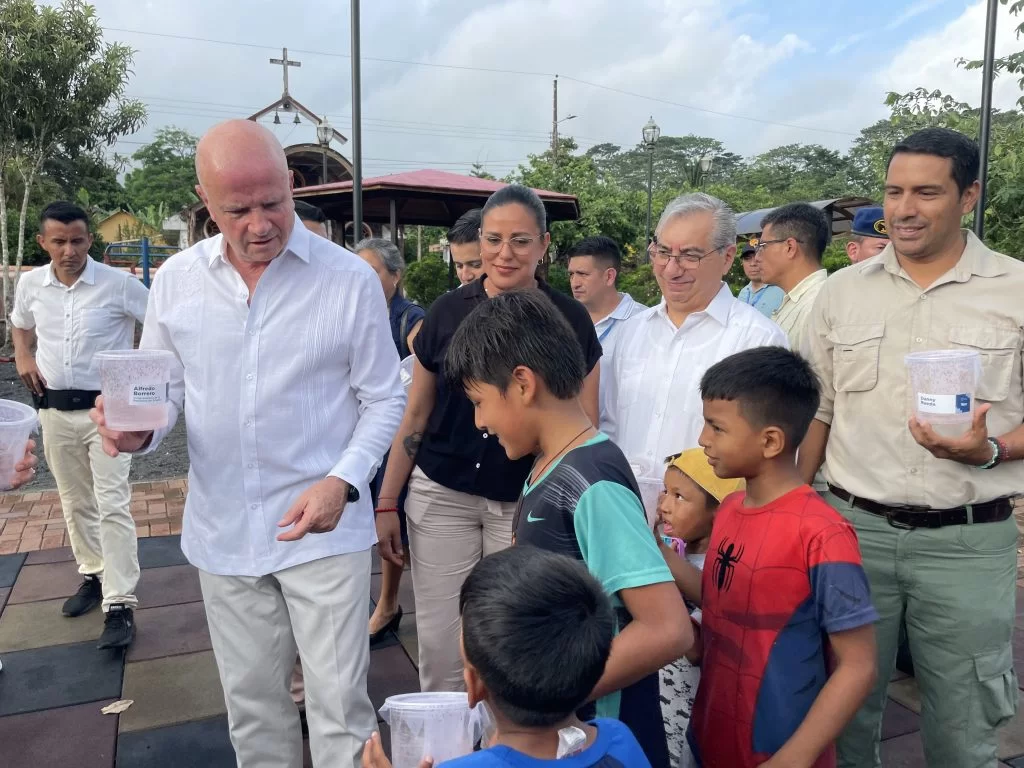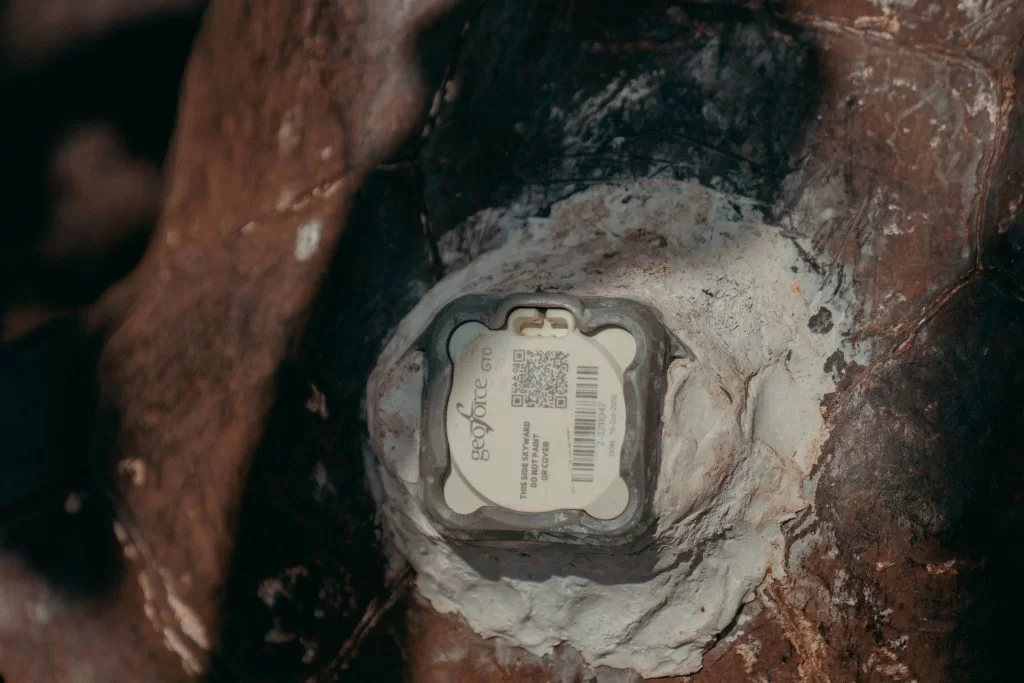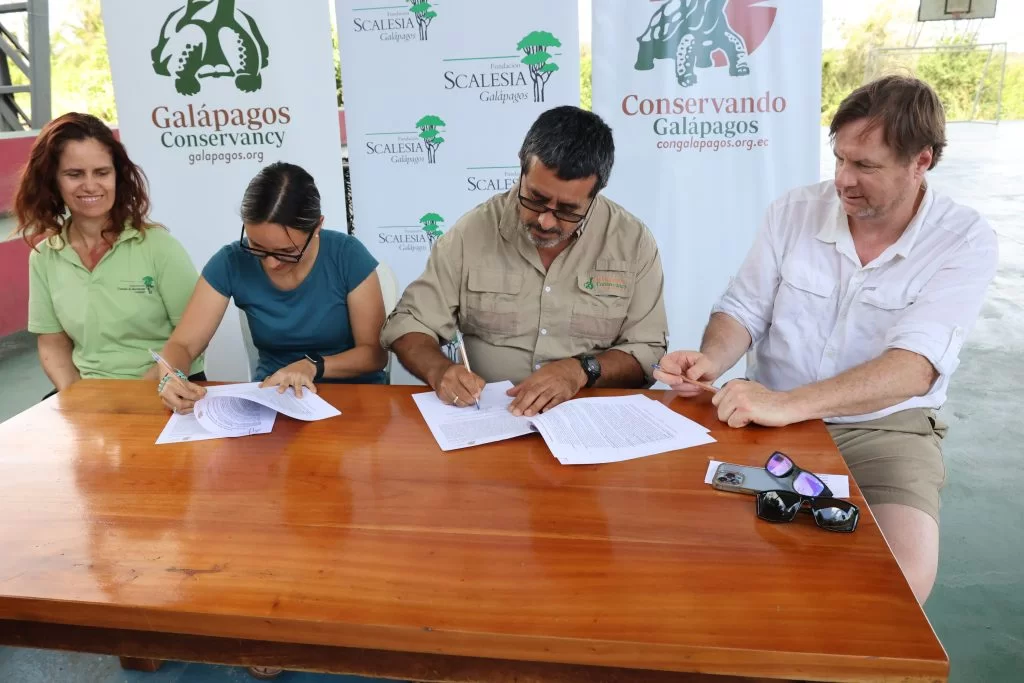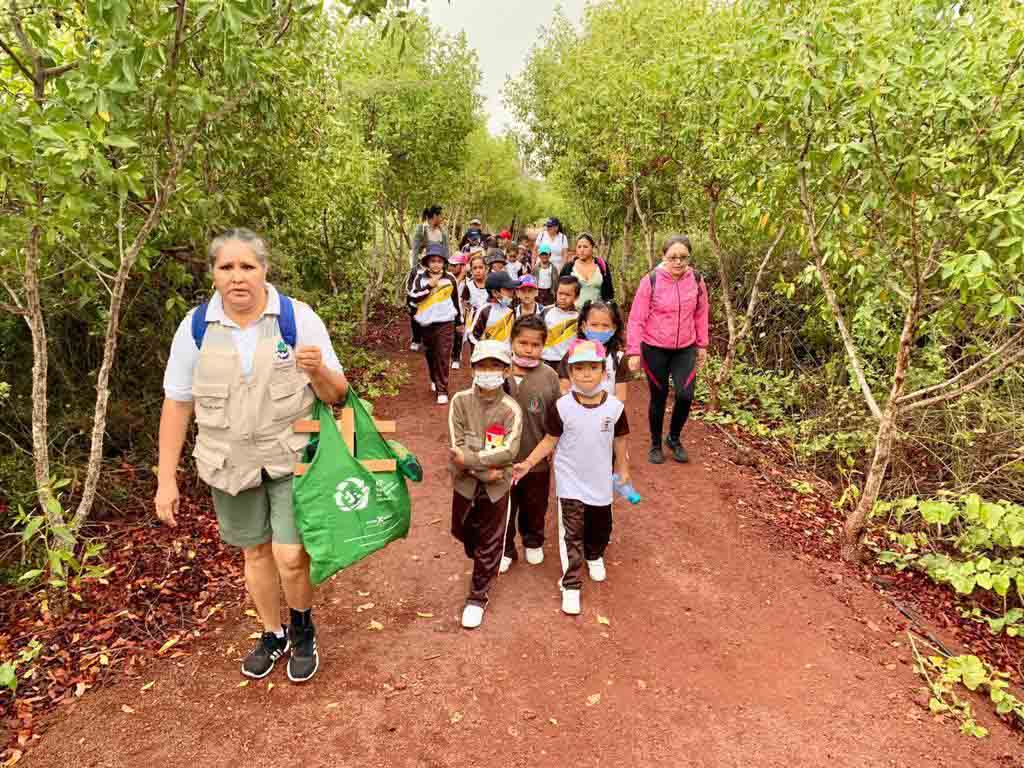The introduced mosquito was first identified in Galapagos in 2001. It is a vector for diseases like Zika, dengue, and chikungunya. Marilyn Cruz, the Executive Director of ABG explained that the project will eliminate the use of insecticides, chemicals, and other pesticides that are commonly used to kill mosquitoes. It also aims to eliminate the problem from the Islands in the long-term.
Six years of research have led to the application of the sterile insect technique for the first time in Ecuador. Experts took mosquito larvae from Galapagos colonies and sterilized them in a laboratory located on Ecuador’s mainland.
These sterile male mosquitoes can be released in Galapagos and mate with wild females. They will eventually extirpate, producing no offspring, and ultimately leading to their eradication. This method is completely eco-friendly, since it doesn’t require chemicals and only impacts the species.
Washington Tapia (General Director of Galapagos Conservancy) and Conservando Galapagos (Partner) congratulated ABG for their continued efforts to protect community and environmental health. He emphasized that “We reaffirm and continue to contribute to the fight against invasive species and to prevent more species from entering the Archipelago.”

10,000 sterile male mosquitoes released in Santa Cruz Island © GNPD
Today is an important date for Galapagos, and the entire world. The Galapagos Islands were discovered officially by Dominican friar Tomas de Berlanga on March 10, 1535. He was sailing from Panama, Peru, when strong ocean currents caused his ship to drift off course to the enchanted Islands.
Berlanga was the first person to provide official descriptions of Galapagos Islands. This is why Berlanga is known as the “Discoverer” and a pioneer in the union of the Atlantic and the Pacific.
Berlanga’s discovery of the Pacific Ocean’s last uninhabited islands was a major turning point in his life. Berlanga wrote to the Spanish king in a later letter. He said that it seemed as if God had rained down stones on Earth. Fortunately, Berlanga and his crew discovered water amid the volcanic terrain and inhospitable conditions at the Galapagos Islands. This is the name Spanish sailors used for the Archipelago. They were greeted by a large number of Giant Tortoises, which reminded them of an old saddle that was called a in Spain. Later, the Archipelago of Columbus would be named for these islands.
Patrick Watkins was the first permanent resident to the Galapagos Islands. He was an Irish sailor and was marooned on Floreana island between 1807-1809. Later, Watkins told of how he survived by hunting and growing vegetables before sailing to Guayaquil in an escaped boat.
According to 2015’s last census, 25,244 people live in the Galapagos Islands. This Archipelago is home to approximately 30,000 people. It has many unique ecosystems that support a wide range of animals and plants.
Galapagos Conservancy wishes Galapagos a happy 488th anniversary. This was the date that this natural wonder was discovered. We are deeply committed and will continue to work to preserve the Islands’ wildlife and ensure the wellbeing of its inhabitants.
Although the Galapagos Pink Iguana first became known in 1986, it wasn’t until 2009 when it was officially declared a new species. It is the only iguana species that can live and forage on the volcanic slopes of its natural habitat.
The Galapagos Pinkiguana, which is estimated to have a population of 200-300 individuals, is one of the most endangered species on the Galapagos Islands. Because it is a rare species and has a small population, habitat destruction and invasive species are all possible.
Galapagos Pink Iguana habitat and species are under threat. Conservation efforts are being made. The species has been listed as Critically Endangered. To protect the Wolf Volcano region, the Ecuadorian government has taken measures, including limiting access and monitoring the iguana populations.
Only scientists and conservationists are allowed to observe the Pink Iguana within its natural habitat due to these protection measures. This rare and stunning creature is an unforgettable sight. Hopefully, Galapaguenos will soon be able to see it in its natural habitat.
Galapagos Conservancy’s discovery of Pink Iguana eggs last year has given new insight into the threats to the iguanas and renewed hope for their survival. Galapagos Conservancy works to preserve the Galapagos Islands’ Pink Iguanas and other rare species by raising awareness and promoting conservation.
PIT tags (Passive Integrated Transponders) are one example of technological innovations we use. They are subcutaneously placed in wildlife. PIT tags are a durable and unique identifier that allows us to track individual animals throughout their lives. This allows us to determine survival rates and population sizes, as well as measure growth rates and movements.
It is important to understand the activity patterns and movements and species, so we use GPS tracking devices which transmit their locations via satellite. Galapagos Conservancy supports Galapagos Whale Shark Project. This project aims to better understand and monitor the breeding and movements of this magnificent marine animal. Individuals are tagged with satellite tracking devices and monitored both inside and outside of the Galapagos Marine Reserve.
Camera traps are placed strategically to help us learn about wildlife behavior and estimate the population size. An infrared motion sensor will automatically capture a photo or video of the animal when it detects its presence. Over 100 camera traps have been hidden on Isabela Island, Wolf Volcano. These traps provide invaluable information about the interactions between Pink and Yellow Iguanas as well as the predatory activities of invasive cats, rats, and nesting habits for the endangered Pink Iguana.
These camera traps also have an important role in detecting poachers and hunters and reporting them in real-time so that we can deploy police and park rangers to arrest them. We would not have the technology to know how to save the Pink Iguana from certain extinction.
Drones have been used to obtain high-resolution imagery of the habitat for tortoises and iguanas and measure their quality. We are also using remotely sensed data from NASA satellites to assess how the Archipelago changes and to plan for future tortoise-rewilding programs.
Molecular genetics is also used to determine the exact species and origin of each individual, as well as genetic variability in rare species populations and levels of kinship. Genetic analysis was used to identify the island of origin of 185 juvenile Giant Tortoises that were taken from animal traffickers last year. These young tortoises will be able to live in the Santa Cruz breeding centre and have their home origins confirmed.
Finally, micrograms of scales and teeth from fishes and sea lions were collected to determine their stable isotope composition using an atomic mass spectrumrometer. This allows us to find out where these animals were born and what they eat.
These technological tools are crucial for conservation and management of Galapagos wildlife. These tools are so valuable and we share them with Conservando Galapagos and the Galapagos National Park Directorate to help promote conservation in Galapagos.

As seen here, GPS tracking devices are attached to the carapaces of Giant Tortoises to help scientists understand their movements, behaviors, and to combat poaching. © Joshua Vela/Galápagos Conservancy
The scholarship recipients will have the chance to get the education and skills they need to succeed in their lives. They will also be able to access a high-quality educational program for free. This program provides critical thinking, bilingual education, as well as experiential learning in an atmosphere of respect, responsibility and solidarity.
Galapagos Conservancy believes that investing in education is an investment in the future and present of society as well as the planet. We will continue to support projects that improve learning, particularly with a sustainability focus. This will contribute to the well-being and care for this amazing natural heritage.

Representatives of Galápagos Conservancy and Fundación Scalesia signing scholarship agreement © Galápagos Conservancy
Education for Sustainability Program is based on the principle that conservation must be done by those who live and work in the Islands. All 7,300 students from PreK-12th grade have been able to learn core topics through month-long deep dives into important topics in Galapagos. These include sustainable food systems, food security, invasive species, sustainable energy, and marine and terrestrial biodiversity.
Sindi Velez, mother to two elementary school students, recalls that learning used to take place only in classrooms and that children did not learn much about Galapagos at school. “It is a joy to see my children outside learning, where teachers help them connect theory and practice and push them together to exchange ideas and work together as they experience their natural surroundings and man-made environment.”
Juan Carlos Valladares is a high school junior who appreciates the chance to learn more about the interplay of environmental, economic, and social realities in the Islands. “We just completed an excellent month learning about the Galapagos Marine Reserve – its most important species and the dangers of overfishing, bycatch, as well as traditional fishing methods that can sustain fisheries. We learned a lot about the environment in our community and were able to see firsthand how we can protect and conserve everything around us.
This major shift in education is centered around 430 Galapagos teachers, who have tirelessly developed new teaching strategies. There are also 40 teacher-leaders involved in professional development of their peers. Patricia Padilla is one of these leaders. She believes that cooperation is the key to success. “Six years ago, teachers from different disciplines had never collaborated. There is now intentionality in the way we interact with each other. While the teaching methods we use are fascinating, teacher collaboration and teamwork is just as important.
Galapagos Conservancy is happy to announce that it has restructured its Education for Sustainability Program this year. It will be transferred entirely to Galapagos by Galapapaguenos. Led by Mr. Lenin Rogel (recently hired), he and his team will ensure that all Islands high school students graduate as conservation-minded architects for a more sustainable Galapagos.

Students on Field Trip © GNPD